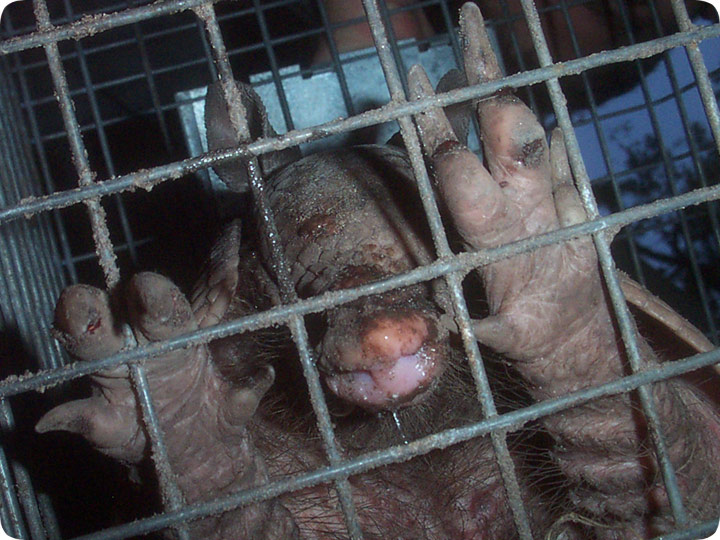-
info@aaanimalcontrol.com
Call us for help in your town
Humane Wildlife Education
Armadillo Cage - Pet Armadillo?

02.06.2007 - The beautiful face of an armadillo. Just look at that snotty nose and those sharp claws! Who
wouldn't want an armadillo for a pet? Why,
you could just keep the armadillo in a cage or a pen, and it would be a fine and loyal companion, with all the benefits of a Golden Retriever, plus a tougher
exterior and barely any shedding. We should all have pet armadillos, right? Right. I mean wrong.
I've received numerous requests over the years for armadillo
specimens to be donated as pets. The problem is that this animal isn't really suitable as a pet. At least, I don't think it is. While the demeanor of the dillo
is just fine and dandy and docile, the problem is that they require a certain type of habitat and food source that can't be easily replicated. They maintain a
large home range with multiple underground burrows, and they dig all of their food out of the ground. I don't think that there's any kind of surface food that
they'll eat. Otherwise, I'd have used it all these years as armadillo bait.
I'm sure that some zoos out there have found a way to keep domesticated armadillos,
and have found some sort of habitat that they'll live in and food that they'll eat, but I think it'd be a challenge. And besides, armadillos sleep about twenty
hours a day, so they wouldn't provide much entertainment. Although an armadillo can catch a Frisbee in its mouth.
Do it yourself: Visit my How To Get Rid of Armadillos page for tips and advice.
Get professional help: Visit my Nationwide Pro Directory of wildlife removal experts.
For more wildlife stories, click my Wildlife Blog
or click my below banner to hire a local trapper.
Armadillo Population - The armadillo population is one that isn't native to North America, but this hasn't stopped it from growing significantly since it moved northwards from its South American origins. One
of the reasons that the armadillo population has grown significantly since it arrived in North America is that the surroundings in the south eastern states particularly are very welcoming for armadillos. This
is because the armadillo came from an area of temperate swampy areas that offered plenty of ground cover, which is quite similar to that which is to be found in its natural homeland.
However, this growth in population in a country which also has a large human population has inevitably brought conflict between people and armadillos. One of the problems about armadillos is that they are often
attracted to areas such as roads, and because they are nocturnal creatures there are many armadillos that are killed on the roads of the USA every year. Another problem is that many yards and gardens will prove
very attractive to armadillos, because the lawns and beds will prove to be very good hunting grounds for armadillos, and they will also often be attracted to the garbage bags and spoiled food that many people will
store in their yards.
The armadillo is an endearing animal that you might want to cage and keep as a pet. It has a beautiful face with an attractive snotty nose and upright ears. The tough exterior makes the critter even more appealing. Who wouldn't want to keep such an animal for a pet? While you may want to keep this unique creature as a pet in your home or house, it has unique challenges that may make it difficult for you to cage it and keep it as a pet. So, you want to pet an armadillo? Let alone keeping an armadillo as a pet, the idea itself is horrible! Even though you might wish to keep the unique animal, the challenges that it comes with are enormous. Below are some of the challenges you may encounter.
Legal requirements
Many municipalities and states in the US do not allow their citizens to keep armadillos as pets. Other states restrict the keeping of the critters to only rehabilitators or educators. Therefore, you can only keep armadillos in these states or areas illegally, which will attract a fine or jail term depending on the state laws on wildlife.
Health risks
Armadillos are generally considered unsafe animals to keep or handle because of the health risk they pose to you and your family. Apart from humans, these critters are the only animals that can carry leprosy. They provide a perfect environment for Mycobacterium leprae- the bacteria that is responsible for leprosy. Leprosy is a chronic disease that can cause nerve damage and disfigure parts of your body. Moreover, some vets are not comfortable with treating armadillos.
Armadillos require a lot of space
If you were to keep armadillos as a pet, it would require a lot of space. In their natural habitat, the critters forage over a large area, a space that you may not have in your home. Also, for the sake of hygiene and health, you should not allow armadillo to roam freely. This means that you will need a large outdoor pen to make the critter comfortable. Since male and female armadillos should not share a pen, you may require an even bigger space for the two.
Dietary challenges
An armadillo diet is not sufficiently understood, which presents a significant challenge if you want to keep the animals as pets. Most of the critters in the wild are insectivores but can feed on worms, plants, and other smaller creatures. Being a nocturnal animal, an armadillo forages mainly at night. Therefore, if you keep one, you will need to stay up late into the night feeding it.
Climate requirement
The different types of armadillos live and thrive in different climates. Their temperature requirement is different. Therefore, if you want to keep an armadillo as a pet, you need to live in an area with a climate comparable to its natural habitat.




















